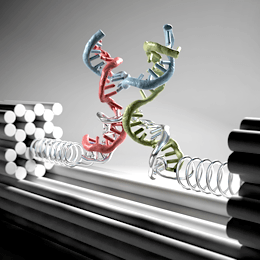Oct 24 2016
 Nanoclamp made of DNA strands. Illustration: Christoph Hohmann
Nanoclamp made of DNA strands. Illustration: Christoph Hohmann
LMU physicists have developed a unique nanotool capable of providing an easy way to characterize the mechanical properties of biomolecules.
Thousands of genes and proteins exist in almost every cell in the body. Biologists are curious about the working of these genes and proteins, how they interact to perform specific functions, and how they react and respond to perturbations. One significant factor noted in all processes relates to the question of how biomolecules respond to the minuscule forces that function at the molecular level.
The team of LMU physicists headed by Professor Tim Liedl, in association with researchers at the Technical University in Braunschweig and at Regensburg University, have developed a method that allows them to apply a constant force on a single macromolecule with dimensions of a few nanometers, and also to examine the reaction of the molecule.
This will enable the team to test whether or not a gene or a protein has the potential to perform normally when its structure is deformed by magnitude forces that are expected in the interior of cells. This new technique of force spectroscopy uses self-assembled nanoscopic power gauges, and it does not require macroscopic tools. This technique can study an increasing numbers of molecules in parallel, which greatly speeds up the process of data acquisition.
The researchers used their new approach to overcome two basic limitations of the force spectroscopy instruments that are commonly used. The molecules under examination are directly linked to a macroscopic transducer in the case of force microscopy and methodologies based on magnetic or optical tweezers.
They need accurate control of an object’s position - a sphere or a sharp metal tip on the order of a micrometer in size - that applies a force on molecules that are attached to that object. The data obtained through this strategy, which is technically extremely demanding, is mostly noisy.
These techniques can only be used to examine molecules one at a time. The new technique dispenses with all these restrictions.
The structures we use operate completely autonomously, and we can use them to study countless numbers of molecules simultaneously.
Philipp Nickels, LMU
A Feather-Light Touch
The Munich group is affiliated with the Cluster of Excellence Nanosystems Initiative Munich (NIM), and its members are acknowledged masters of “DNA origami”. This technique exploits the DNA’s base-pairing properties to construct nanostructures from strands that fold up and pair locally in a manner established by their nucleotide sequences.
In the present scenario, the DNA sequences are programmed in a way that allows them to interact with each other so that the final structure obtained is a molecular clamp that can be programmed to apply a defined force on a test molecule. A single-stranded DNA containing a particular sequence that has the potential to recruit the molecule of interest spans from one arm of the clamp to the other arm.
Changing the length of the single strand base by base allows tuning the applied force. “That is equivalent to stretching a spring ever so-o-o slightly,” says Nickels. It is possible to exert extremely small forces between 1 and 15 pN (1 pN = one billionth of a Newton) – comparable in magnitude to those that act on genes and proteins in cells. “In principle, we can capture any type of biomolecule with these clamps and investigate its physical properties,” says Tim Liedl.
The impact of the applied force is read out using the Förster Resonant Energy Transfer (FRET) phenomenon.
FRET involves the transfer of energy between two fluorescent dyes and is strongly dependent on the distance between them.
Professor Philip Tinnefeld, TU Braunschweig
When force used to test the molecule is enough to deform it, the distance between the fluorescent markers is modified and the magnitude of energy transfer is an accurate measure of the distortion of the test molecule on the nanometer scale.
The team, in collaboration with Dina Grohmann from Universität Regensburg, used the newly developed technique to examine the characteristics of the TATA Binding Protein, which is a vital gene regulator binding to a particular upstream nucleotide sequence in genes and helps to trigger their expression.
The researchers discovered that the TATA protein will not be able to perform its normal function if its target sequence is subjected to a force that goes beyond 6 pN. The new technique has just made its debut, however, since the clamps are minuscule and operate autonomously it could be possible to use them in the future to study molecular processes in living cells in real time.